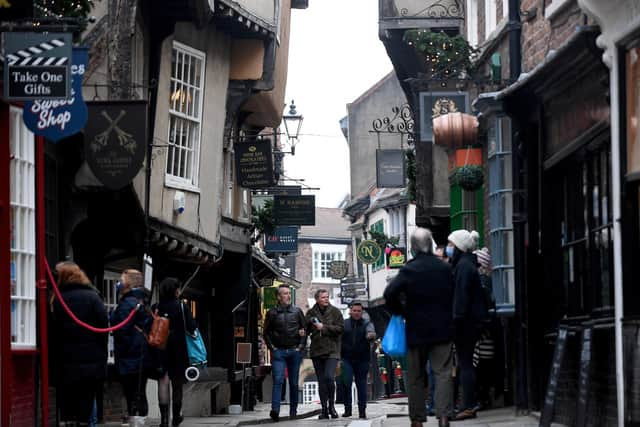Yorkshire-born art historian, author and former Sotheby's UK chairman on country's heritage and the conservation of York
At North Yorkshire’s Ampleforth College, he discovered the work of both William Morris, an artist, architectural conservationist and social activist, and John Ruskin, writer, philosopher, art critic and pioneering conservationist.
York-born Stourton, an art historian, author and the former chairman of Sotheby’s UK, tells of how they stimulated his development, writing of the pair in the introduction to his latest book – Heritage: A History of How We Conserve Our Past.
Advertisement
Hide AdAdvertisement
Hide Ad"Under Morris’ influence, I took up calligraphy and printing, and he led me to John Ruskin and my first encounter with the 1880s conservation movement,” Stourton writes. “Like Ruskin, Morris opened many avenues and introduced me to the idea of building protection, something that seemed oddly irrelevant to the rest of 1960s Britain.”


Another pivotal moment for Stourton came with watching Kenneth Clark’s Civilisation, a television documentary series from the late art historian, which explored the history of Western art, architecture and philosophy. "Seeing that confirmed I wanted to live my life with art,” Stourton says, “and live my life in a European context, which is what I’ve done.”
He read history of art at the University of Cambridge, before joining the painting department at Sotheby’s as a cataloguer in 1979. “Sotheby’s was the world leader. It’s difficult to imagine today the influence and extraordinary weight that the duopoly of Sotheby’s and Christie’s had in the world,” he says. "They were utterly dominant of the whole art market.”
Stourton rose through the ranks, taking on various positions with the firm including deputy chairman of its European arm and later UK chairman. All the while, he wanted to write, and he produced the first four of his books whilst working at Sotheby’s, covering topics such as art collectors, museums and London's grand houses.
Advertisement
Hide AdAdvertisement
Hide AdWhen he was offered the chance to produce a biography of Clark, Stourton left Sotheby’s and started to write full-time. It also gave him the opportunity to join several heritage committees including the Acceptance in Lieu Panel. The group advises ministers on items offered under a scheme enabling taxpayers to transfer important works of art and heritage objects into public ownership.


Stourton, now based between London and Dorset, has also been involved in the Heritage Memorial Fund, which awards grants to safeguard the UK’s most important heritage treasures, as well as being a senior fellow of the Institute of Historical Research at the University of London.
It is against this backdrop that his latest book on heritage came about. It explores what heritage is, when it was invented and its place in the world today. Stourton focuses on elements of the cultural and natural environment that have been deliberately preserved - from the British countryside and national parks to buildings such as Blenheim Palace and Tattersall Castle, and the works of art inside them. “I sat on heritage committees for ten years and it made me interested in the mechanics of heritage and why we got to where we are today,” Stourton explains.
"I talked to a lot of people who knew about the subject and one would say you must have a chapter on museums, another would say a chapter on archaeology, but what I realised was the threads were very much landscape,” he continues. “Preservation of landscape is the leitmotif of the story. I also realised that all impasses of heritage were invented by the Victorians except for three.”
Advertisement
Hide AdAdvertisement
Hide AdThree strands that the post-war generation can feel proud of, he says, are area conservation, volunteerism, and regeneration, which he claims has taken heritage “from being seen as something past and something distant into being a locomotive for economic change”.
In one chapter, Stourton, who was brought up in North Yorkshire in the Allerton Park estate, explores how York became “the poster boy for the conservation movement” from the 1960s, thanks in particular to the city’s Civic Trust and John Bowes Morrell, the founder of York Conservation Trust. York, he explains, embraced the designation of conservation areas, which today exist to manage and protect the special architectural and historic interest of a place and the features that make it unique.
Stourton charts two historic periods of conservation – the 1880s and 1960s – and considers whether threats such as rampant development are similar in the present day. Reflections on post-war planning shaped thinking during that latter period, whilst rapid urbanisation was a driver of change in the 1880s, he says.
“That caused people to start thinking about how we live in cities and what we preserve. We can’t just go on knocking things down and destroying countryside...The idea that there are things worth preserving was very much something that came out of that period.”
Advertisement
Hide AdAdvertisement
Hide AdToday, heritage plays many roles, from preserving landscapes, to protecting wildlife habitats, regenerating cities and promoting culture. “Heritage is you,” Stourton reflects. “It’s who you are, where you come from, the street you live in, the place you were born, the park you visit, your high street. It’s all about your environment and the quality of your life. Heritage is everything that you would like to see preserved for historical, for beautiful, and for associational reasons. We can’t preserve everything, life is dynamic. But we can preserve the essentials.”
Heritage: A History of How We Conserve Our Past by James Stourton, is published by Head of Zeus and is out now.
